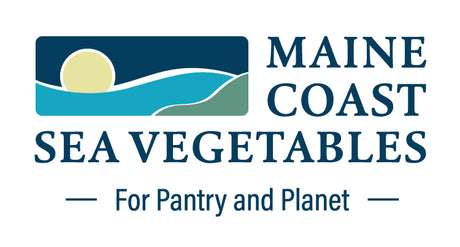Wild Seaweeds Sourced from the Gulf of Maine
Maine Coast Sea Vegetables had its beginnings in Franklin, Maine, at the very head of Frenchman's Bay. Our certified organic sea veggies are hand harvested from the rocky, sparsely populated Downeast Maine coast between Bar Harbor and Eastport, on up to Grand Manan Island, Canada, just 16 miles from Eastport and over to the outer shores of Nova Scotia. The harvest season starts with sugar kelp in early April, with snow pack often still on the ground and the shallow coastal inlets still frozen. It continues through summer until the low tides of October bring us our last dulse — if we're lucky!
Our Harvest Area and Headquarters
Our Seaweeds are Certified Organic
You may wonder why we go to the trouble and expense to remain certified organic by the Organic Crop Improvement Association (OCIA), even though we already test our dried seaweeds for contaminants. It's true that compared to land plants, we have little control over the growing conditions of our wild marine plants. But we do have choices about how, when, where, and how much we harvest, as well as how the seaweeds are transported, dried, stored and packaged.
The National Organic Program (NOP) Standards address all these areas and help ensure sustainability. These standards give clear and uniform direction to all responsible parties for harvesting and handling these gifts from the sea on their way to your table. Definitely worth the trouble!

Dulse being rolled up after solar drying
Harvesting for a Superior Product
It takes many hands to bring sea veggies from the sea to your plate. Perhaps none are more important than the harvesters who gather the wild plants from the beds where they grow in remote bays. Kelp harvesters are the first to don wet suits or hip boots and get their boats in the water in early April. If it's too cloudy to solar dry the freshly harvested crop it may be dried indoors using wood heat or forced hot air. Our sea vegetables are always dried at mild temperatures to preserve them as a raw food with enzymes and nutrients intact.
Since 1993 every step has been accomplished following the world's first organic certification standards for sea vegetables. This means that each harvester monitors their beds for sustainability and keeps the freshly picked plants free of possible contaminants throughout harvest, transport, drying and packing. Harvesters are randomly inspected for compliance, and our processing plant in Hancock Maine is as well. Quality and safety are further ensured through a rigorous testing program for water borne contaminants such as heavy metals, pesticides, bacteria, and yeasts and molds.
